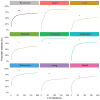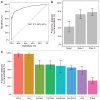Detection and localization of surgically resectable cancers with a multi-analyte blood test
- PMID: 29348365
- PMCID: PMC6080308
- DOI: 10.1126/science.aar3247
Detection and localization of surgically resectable cancers with a multi-analyte blood test
Abstract
Earlier detection is key to reducing cancer deaths. Here, we describe a blood test that can detect eight common cancer types through assessment of the levels of circulating proteins and mutations in cell-free DNA. We applied this test, called CancerSEEK, to 1005 patients with nonmetastatic, clinically detected cancers of the ovary, liver, stomach, pancreas, esophagus, colorectum, lung, or breast. CancerSEEK tests were positive in a median of 70% of the eight cancer types. The sensitivities ranged from 69 to 98% for the detection of five cancer types (ovary, liver, stomach, pancreas, and esophagus) for which there are no screening tests available for average-risk individuals. The specificity of CancerSEEK was greater than 99%: only 7 of 812 healthy controls scored positive. In addition, CancerSEEK localized the cancer to a small number of anatomic sites in a median of 83% of the patients.
Copyright © 2018 The Authors, some rights reserved; exclusive licensee American Association for the Advancement of Science. No claim to original U.S. Government Works.
Figures



Comment in
-
Diagnosis: CancerSEEK and destroy - a blood test for early cancer detection.Nat Rev Clin Oncol. 2018 Mar;15(3):133. doi: 10.1038/nrclinonc.2018.21. Epub 2018 Feb 6. Nat Rev Clin Oncol. 2018. PMID: 29405203 No abstract available.
-
Cancer detection: Seeking signals in blood.Science. 2018 Feb 23;359(6378):866-867. doi: 10.1126/science.aas9102. Science. 2018. PMID: 29472467 Free PMC article. No abstract available.
-
Early detection: a long road ahead.Nat Rev Cancer. 2018 Jul;18(7):401. doi: 10.1038/s41568-018-0021-8. Nat Rev Cancer. 2018. PMID: 29769632 No abstract available.
-
[Early diagnosis and localization of cancer by liquid biopsy].Pathologe. 2018 Jul;39(4):328-329. doi: 10.1007/s00292-018-0454-6. Pathologe. 2018. PMID: 29951738 German. No abstract available.
-
Multi-analyte assays and early detection of common cancers.J Thorac Dis. 2018 Jul;10(Suppl 18):S2165-S2167. doi: 10.21037/jtd.2018.06.58. J Thorac Dis. 2018. PMID: 30123550 Free PMC article. No abstract available.
References
Publication types
MeSH terms
Substances
Grants and funding
LinkOut - more resources
Full Text Sources
Other Literature Sources
Medical
Molecular Biology Databases

